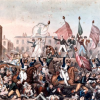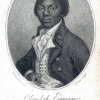Timeline: Race, Gender, Class, Sex
Created by Dino Franco Felluga on Wed, 08/19/2020 - 16:28
Part of Group:
 This timeline is part of ENGL 202's build assignment. Research some aspect of the nineteenth century that teaches us something about race, class, or gender and sexuality and then contribute what you have learned to our shared class resource. As the assignment states, "Add one timeline element, one map element and one gallery image about race, class or gender/sex in the 19th century to our collective resources in COVE. Provide sufficient detail to explain the historical or cultural detail that you are presenting. Try to interlink the three objects." A few timeline elements have already been added (borrowing from BRANCH).
This timeline is part of ENGL 202's build assignment. Research some aspect of the nineteenth century that teaches us something about race, class, or gender and sexuality and then contribute what you have learned to our shared class resource. As the assignment states, "Add one timeline element, one map element and one gallery image about race, class or gender/sex in the 19th century to our collective resources in COVE. Provide sufficient detail to explain the historical or cultural detail that you are presenting. Try to interlink the three objects." A few timeline elements have already been added (borrowing from BRANCH).
Timeline
Chronological table
|
Date |
Event | Created by | Associated Places | |
|---|---|---|---|---|
| 16 Aug 1819 |
Peterloo massacre
Related ArticlesJames Chandler, “On Peterloo, 16 August 1819″ Sean Grass, “On the Death of the Duke of Wellington, 14 September 1852″ |
David Rettenmaier | ||
| 12 Jul 1819 |
Britain approves settlement scheme to South AfricaOn 12 July 1819, the British government approved £50,000 for a settlement scheme to South Africa's eastern Cape. Articles |
David Rettenmaier | ||
| 28 Jun 1819 |
Stockport meetingOn 28 June 1819, at the great Stockport meeting, the largest of its kind besides Peterloo, upwards of 20,000 assembled to hear Sir Charles Wolseley speak on Parliamentary reform. Articles |
David Rettenmaier | ||
| 15 Feb 1819 |
Sandy Brow FightOn 15 February 1819, William Fitton presided at a public meeting at Sandy Brow in Stockport (the so-called “Sandy Brow Fight”), number present not known, where a scuffle involving stones and brickbats occurred over an attempt by the military to seize the Cap of Liberty; the Riot Act was read three times. Articles |
David Rettenmaier | ||
| Mar 1814 to Jun 1827 |
New Harmony, IndianaOriginally founded by the Harmonie society under the leadership of German Immigrant George Rapp, New Harmony, Indiana was formed due to the increasing populations and costs of land in Harmony, Pennsylvania, that threatened their desire for solitude. A religious society with aspects of German culture, New Harmony found great success along the Wabash river. In stark contrast to the society following it, it was extremely well planned, self-sufficient with it's own factories and workers. They thrived until 1824, when George Rapp received a prophecy about the second coming of Christ, forcing him to move back to Pennsylvania. When he put the town up for sale, it was bought by Robert Owen, a wealthy industrialist and socialist who hoped to eliminate the growing class divide of the industrial revolution. He sought to bring together scholars and academics from all over the US, but let anyone join the society. Because of this, there was a large shortage of skilled craftsmen, and poor management and planning. In 1826, in an effort to unite this society, they wrote a new constitution, which was based on equal rights and duties, which would also hopefully bring more management to the society and train the children to become skilled craftsmen. But this was not enough to unite the people, as Robert Owen himself was a flawed leader. For one he had an open distaste for organized religion, which split much of the community. His ideals drove away farmers, upset anarchists, and divided the common people. And finally, he struggled to receive the same amount of donations that he had in Europe. Due to this disorganisation and lack of unity, New Harmony, Indiana broke apart into smaller, separate communities in 1827, and then eventually entirely dissolved in 1829. Works Cited (Timeline)
“New Harmony, Indiana.” Wikipedia, Wikimedia Foundation, 10 Aug. 2020, en.wikipedia.org/wiki/New_Harmony,_Indiana.
Owen, William. Diary of William Owen fromto April 20, 1825. ed by Hiatt, Joel W Indianapolis, The Bobbs-Merrill Company, 1906. Pdf. Retrieved from the Library of Congress, <www.loc.gov/item/10014024/>. The Editors of Encyclopaedia Britannica. “New Harmony.” Encyclopædia Britannica, Encyclopædia Britannica, Inc., 22 July 2011, www.britannica.com/place/New-Harmony. Wilson, William Edward. The Angel and the Serpent: the Story of New Harmony. Indiana University Press, 1992. |
Steven Kelly | ||
| 22 Jun 1802 |
Criminal Jurisdiction Act passed
Articles |
David Rettenmaier | ||
| 1 Jan 1792 |
Vindication of the Rights of Woman
ArticlesAnne K. Mellor, "On the Publication of A Vindication of the Rights of Woman" Related Articles |
David Rettenmaier | ||
| 14 Jul 1789 to 14 Jul 1789 |
Storming of the BastilleThe Storming of the Bastille, dated July 14th, 1789, created a disturbance in class shift in French society. The hierarchy on the upper half was the clergy, and then the nobility in that order; the third estate consisted of peasants and workers, whom of which built up 80% of the population. Despite making up such a large portion of the population, they were still below under the poverty line and treated as lesser humans. The significance behind the Bastille is it was not just a normal prison; it was used as a monarch-operated prison as the king could imprison anyone he felt was a danger to his rule. The main intention of the protestors was to overwhelm the guards and gain control of the weapons beings stored within. The actual storming happened within a single day, as it started with negotiations between the Third Estate and the guards of the Bastille, but quickly turned violent as peasants stormed the prison. Although this one event did not single-handedly bring down the class structure implemented into France’s society, it was quite possibly the largest event in the broader category of the Revolution of 1789. However, what the Storming of the Bastille did contribute to was the lynching of two big figures under the monarchy, Joseph Foullon De Doue (the head of finances) and Louis Bénigne François Bertier de Sauvigny (an attendant). It also inspired the population around France to create municipalities for civic government. Works Cited: Dowson, Thomas. Finding Remains of the Bastille in Paris Today. 14 July 2019, archaeology-travel.com/travel-reports/where-is-the-bastille-today/. History.com Editors. “Bastille Day.” History.com, A&E Television Networks, 21 June 2017, www.history.com/topics/france/bastille-day. “Storming of the Bastille in the French Revolution.” History Crunch - History Articles, Summaries, Biographies, Resources and More, www.historycrunch.com/storming-of-the-bastille.html. “Storming of the Bastille.” Wikipedia, Wikimedia Foundation, 7 Oct. 2020, en.wikipedia.org/wiki/Storming_of_the_Bastille. |
Nate Hood | ||
| Jan 1789 |
Interesting Narrative of the Life of Olaudah Equiano
Articles |
David Rettenmaier | ||
| 9 Apr 1787 |
First settlers depart for Sierra Leone
Articles |
David Rettenmaier |






